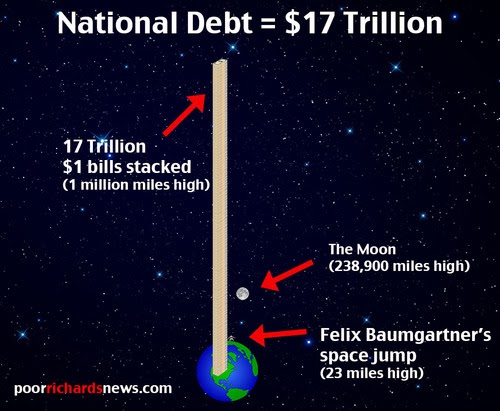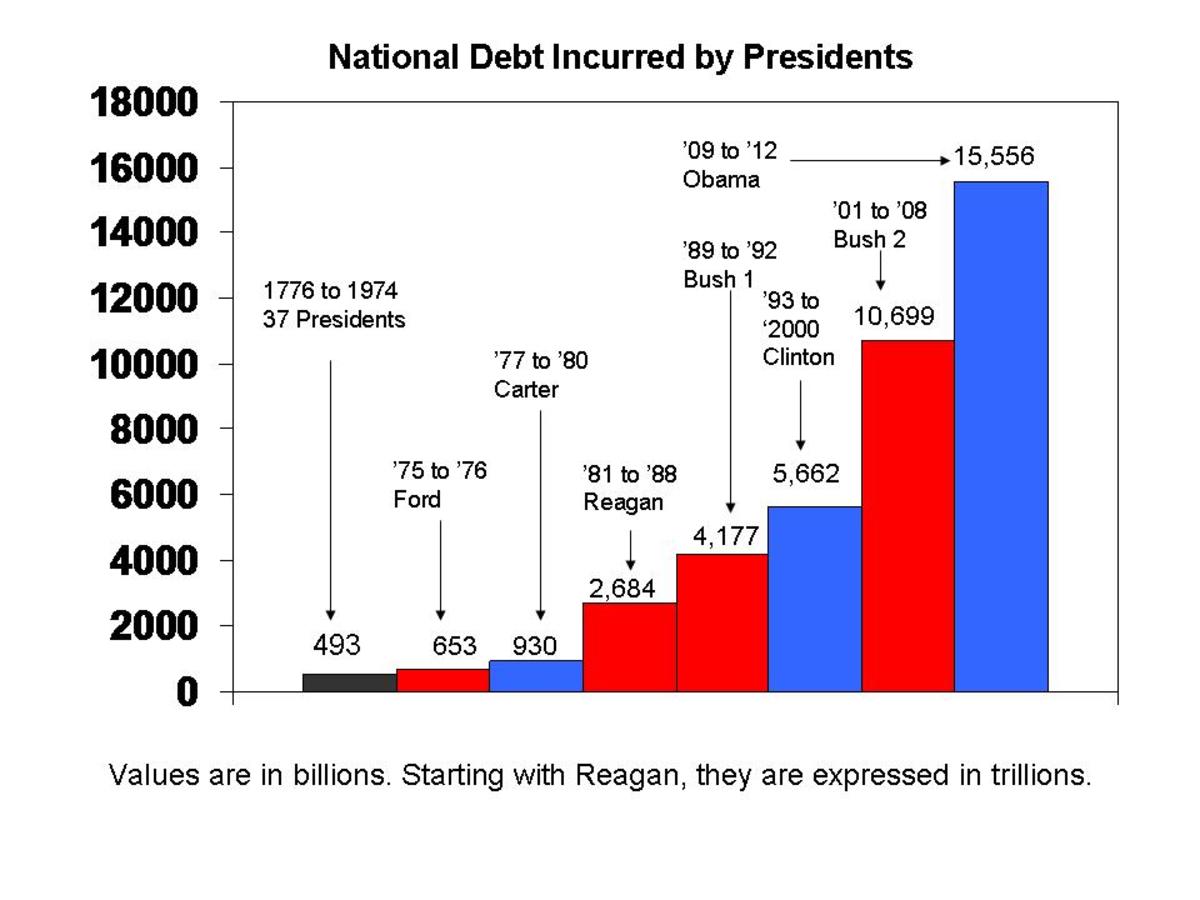The American National Debt

17 Trillion Dollars!!!
Yes, that's right. America's national debt now stands at around 17 TRILLION DOLLARS!
Whoa, there. That's a whole lot of money! But what does this really mean? How do we translate this incredibly big number into something that means something to each individual American?
Americans have got very jaded when it comes to debt. We have, collectively, got very used to accruing more debt than we can pay off with our current assets. We got used to this both as individuals and as a nation. Governments follow this trend, to keep accumulating debt that CANNOT be ever, ever, fully paid off just as rapidly as we do collect debt rapidly as individuals.
In other words, 17 trillion dollars of debt is unsustainable.
When your debts exceed your assets, you are no longer solvent. As an individual, as a company or corporation, often this state of affairs leads to bankruptcy. When there is routinely more money going out than coming in, that fiscal situation is NOT indefinitely sustainable.
Eventually, the United States government will be bankrupt. Indeed, we are already, only bankruptcy has not been declared yet. We are in debt so far we can NEVER get out. We can only get further and further into debt. This situation is dire and getting worse. And there are no remedies available to us at this point, so we are just maintaining status quo for as long as we can, using the means of increased debt. We do not want to sacrifice our collective lifestyle here in America. This country has been good to most of us. We like our plethora of readily available consumer goods. We like our high standards of living. We like feeling secure of our military strength. We like all the advantages of living in one of the "richest" countries in the world.
A few Facts:
What is this debt: What does it consist of?
The total National Debt is actually about 17 trillion dollars. This is the United States public debt. It is the amount owed by the United States government to the public: that is, the total value of Treasury securities that have been issued by the Treasury and other federal government agencies which are outstanding. T-bills, which investors buy for the interest that accrues, are one sort. The other sort of Treasury bill is a non-marketable Treasury note which secures (ha-ha-ha!) accounts administered by the federal government on behalf of beneficiaries, such as the Social Security Trust Fund.
The United States TOTAL debt, including personal and business debt as well as state and local governments and financial institutions is about $60.2 trillion dollars.
Debt per citizen: $54,000
Debt per taxpayer: $150,000
tax revenue: $2.9 trillion dollars
federal spending: $3.5 trillion dollars
Federal Spending: The Large Budget Items
Medicaid/ Medicare: $770 billion dollars
Social Security: $811 billion dollars
Interest on debt: $256 billion dollars
Federal Pensions: $230 billion dollars
Our federal deficit exceeds our gross domestic product by about one trillion dollars. This is huge and this is awful. We owe more than we collectively produce. Everything we do, all the work we do and the money we get paid, if we turned over all the proceeds from each and every one of our employments, it would not, repeat NOT erase our federal deficit, let alone the rest of the debt we have accumulated as a nation.
We, as a nation, have about 16 trillion dollars in personal debt. Here are some of the big ticket items:
mortgage debt: 12 trillion
student loans: 1 trillion
credit card debt: about 1 trillion
The total United States amount of unfunded liabilities unsupported by assets equals 127 trillion dollars. That's a total unfunded liability of 1 million dollars per taxpayer.
Okay, you're saying. How can this be? How can the unfunded liabilities equal 127 trillion dollars when the total DEBT is (ONLY!) 60.2 trillion dollars? The answer lies in the stock market, and something called "buying stocks and bonds on margin", which is a purchase only secured by the value of the stocks or bonds themselves. When the market fluctuates, the value of the stocks and bonds change, causing some unsecured liabilities. Let's hope there are no margin calls in the near future! The whole apple cart would tip over, I fear.

Let's Make it Real
So, just to get a perspective on the situation, 17 trillion dollars is enough to carpet a few states completely in dollars bills. It's enough to circle around the sun a couple of times from Earth, should we lay those dollar bills end to end.
And as a figure for debt, it is completely unsustainable.
We are in endgame, I think. How long can we keep up this cycle of spending and borrowing and spending and borrowing, only to spend yet more? We are keeping our government and our economy going on borrowed money. Borrowed money is borrowed time, and with no way to pay the money back or even reduce the debt, a crash is inevitable.
I'm afraid that the crash has been delayed long enough now to be a really, really bad one when it does come. We've kept the whole circus going with spit, chewing gum and baling wire for so very long now that the crash, when it comes, will change life in America as we know it. There won't just simply be a period of economic depression while the entire system self-adjusts to a sustainable model. Oh, no, I'm afraid we're in much more trouble than that. I'm afraid that our basic currency will be no good at all and have no value, and we will end up reaching for the things that sustain life: food, water, shelter...without any viable civilized medium of exchange.
I'm not the only one who fears this. There are businesses doing a booming rush of business for building something called "survival bunkers", where extremely wealthy people purchase a pre-built bunker which is then inserted into the ground in a secret location which has all the amenities; and can sustain people for up to six years without any outside air, water, food or sanitation. An inexpensive one costs about $450,000.
You know, I wish I could afford one.
Guess I'll just have to take my chances with the rest of the world. Maybe it won't be quite so bad as I fear. Maybe we can re-establish a better system of values in the long run, with only a period of re-adjustment that's healthy.









